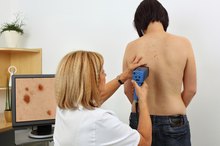Facts About Red Moles
Noticing a red mole on your skin can be worrisome. What is it? Is it dangerous? While it's good to pay attention to growths and spots on your skin, don’t panic. A mole -- what medical professionals call a nevus -- is a type of skin growth that occurs when color-producing cells in your skin grow in a cluster. They are usually round or oval, can be raised or flat and may be black, brown pink or red. Most red moles are not cancerous. Other types of common skin growths can also be mistaken for red moles.
Atypical Moles
Most moles range from light tan to dark brown. However, atypical moles -- also known as dysplastic nevi -- can include shades of red along with brown.
These moles often include a mixture of colors, may appear speckled and are usually flat or slightly raised. The edges are often irregular and the border fuzzy.
Atypical moles are frequently larger than common moles and are often broader than the width of a pencil eraser.
They can develop at any age and occur anywhere on the body, although they most commonly occur on the back, chest and scalp. Atypical moles are most common in fair-skinned people and should be examined by a doctor to ensure they are not cancerous.
- Most moles range from light tan to dark brown.
- Atypical moles are frequently larger than common moles and are often broader than the width of a pencil eraser.
Spitz Nevi
What Kinds of Growths Form on Aging Skin?
Learn More
A Spitz nevus is a special type of mole that is often red, pink or light brown, but it can include a mixture of colors. These growths are typically raised like a dome and tend to bleed if scratched. They most often develop on the head, neck, arms or legs and are usually less than a half inch across. They most commonly develop in fair-skinned people and usually appear in childhood, although they can occur in adults. A Spitz nevus often grows quickly, but this type of mole is noncancerous.
However, it can sometimes be difficult to distinguish a Spitz nevus from a cancerous skin growth. Doctors sometimes remove a Spitz nevus to be sure it is not cancerous.
- A Spitz nevus is a special type of mole that is often red, pink or light brown, but it can include a mixture of colors.
- A Spitz nevus often grows quickly, but this type of mole is noncancerous.
Cherry Angiomas
Cherry angiomas look like small red moles, but they are actually not skin growths. They are small collections of blood vessels close to the skin surface. **They are typically raised and smooth and appear most often on the chest, back and upper arms.
Cherry angiomas are very common and affect people of all races. They usually begin appearing in adults during their 30s or 40s and often increase in number with advancing age. Cherry angiomas are not cancerous. ** Because they are made up of blood vessels, they tend to bleed if nicked.
- Cherry angiomas look like small red moles, but they are actually not skin growths.
Actinic Keratoses
Examples of Harmless Skin Moles
Learn More
Actinic keratoses are not moles but may resemble them 4. Usually red or reddish-brown, they are rough, irregular in shape with indistinct edges and of varying size. These growths are typically scaly and might flake off, but they will usually come back.
Actinic keratoses are precancerous and develop due to sun damage. They most often occur in areas frequently exposed to the sun, including the nose, face, ears, scalp and arms. They occur most frequently in fair-skinned people and usually develop in late adulthood.
- Actinic keratoses are not moles but may resemble them 4.
Cautions
Not all red moles are cause for concern.
However, it is important to get any new or changing skin growth checked by a doctor. Itchiness, bleeding and oozing may signal the development of skin cancer. Any skin growth larger than a pencil eraser should also be checked by a doctor.
- Not all red moles are cause for concern.
- Any skin growth larger than a pencil eraser should also be checked by a doctor.
Related Articles
References
- Managing Skin Cancer; Eggert Stockfleth, et al.
- Field Guide to Clinical Dermatology, Second Edition; David H. Frankel
- Family Practice Notebook: Senile Angioma
- Family Practice Notebook: Actinic Keratoses
- National Cancer Institute: Common Moles, Dysplastic Nevi, and Risk of Melanoma
- American Cancer Society. Key statistics for melanoma skin cancer. Updated August 14, 2019.
- Children's Hospital of Philadelphia. Congenital nevus (mole).
- U.S. National Library of Medicine Genetics Home Reference. Are moles determined by genetics? Updated December 2017.
- National Cancer Institute. Genetics of skin cancer (PDQ) - health professional version. Updated January 3, 2020.
- American Society of Clinical Oncology. Melanoma: symptoms and signs. Updated January 2019.
- Skin Cancer Foundation. Melanoma warning signs. Updated April 2019.
- National Cancer Institute. Melanoma risk assessment tool.
- American Cancer Society. How to Spot Skin Cancer. Updated 07/06/17.
- Canadian Cancer Society. Signs and Symptoms of melanoma skin cancer.
Resources
Writer Bio
Dr. Jill Herr has been a primary care physician for over 10 years and a medical writer since 2012.









